FEATURE REVIEW
THE GAME OF KINGS
THREE ST CHESS PROGRAMS FIGHT IT OUT
By Christopher F. Chabris
Contributing Editor
At the first START magazine ST chess tournament, there weren't huge crowds. In fact, there weren't any spectators at all--just the participants, battling with knight and rook and pawn for days on end, in round after round of the Game of Kings. When it was finally over, and three human and five computerized players had ended their final matches, a new computer champion had emerged--one stronger than the best 1970s-era mainframe chess programs!
THE ST PLAYERS
There were three ST chess programs in the tournament: Chessmaster 2000 from The Software Toolworks and Electronic Arts, Psion Chess from Psion Limited and Atari Corp., and Techmate, from Szabo Software and MichTron. All three programs run on any ST--520 or 1040, monochrome or color. Each is completely graphics-oriented; the positions of the pieces on the two-or three-dimensional mouse-controlled board displays are readily discernible and don't strain your eyes. Each game will play either White or Black, allow you to and recognize (and use) all the standard rules of chess.
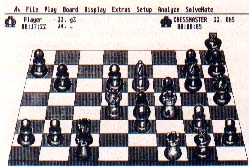 |
| FIGURE 1: Chessmaster 2000 |
CHESSMASTER 2000
I had high hopes for Chessmaster 2000 from The Software Toolworks (distributed by Electronic Arts). It arrived on the scene with a fanfare of glowing reviews for all the previous versions and David-and-Goliath stories of its victory at the l986 U.S. Open Computer Championship. I was very impressed with every aspect of the program, including its documentation and support of unusually high quality for the computer game industry.
Chessmaster 2000 offers the most, and best, features of any chess program on the market. You can adjust or turn on or off almost every feature, and alter the default settings as you desire. The play screen displays two chess clocks, and the GEM user interface conventions are followed well. Even though it's the most complex of the three programs and offers no online help, Chessmaster 2000 is easy and straightforward to use. The three-dimensional board display is realistic and pleasant, although the mouse control of piece movement is quite rough. Since you have to hold down the mouse button while you move your chosen piece to its destination square, it's easy to slip and make the wrong move; the requirement that you place the base of the piece fully within the desired square only makes this problem worse.
Although Chessmaster 2000 provides twelve levels of play, represented by various average time consumptions and ranging from 60 moves in five minutes to one move in 100 hours, I would also like to see "sudden death" time controls and unlimited board layout customization. An alternate screen, accessible from a menu or the Escape key, displays the captured pieces, game score, and Chessmaster 2000's analysis and evaluation of the position. You can set up positions, save and load games (your own or 100 provided classics, including two by Chessmaster 2000 itself!), request hints, and have the program display all legal moves in a position (both useful for beginners).
Among Chessmaster 2000's more exotic features are its choices of "metal" or "wood" pieces, differing board colors (color monitor only), an "If the Boss Wanders By" menu selection that pops up a mock spreadsheet screen, and a coffeehouse playing style for novices that randomizes its move selection a little bit. You can even enter your name for display on screen instead of simply "Player." A very understandable digitized voice is available to announce the program and its moves--good if you don't pay full attention to your game, but a waste of time if you do. Fortunately, you can toggle the voice or the program's alternate music on or off.
The well-written documentation for Chessmaster 2000 includes a generic introduction to the game of chess and brief commentaries on the classic games as well as an ST-specific leaflet that explains the use of the program. Chessmaster 2000 suffers from only a couple of unimportant bugs--occasionally, a drop-down menu will remain down until you close it. The main disk of the two supplied in the package is copy-protected, but a backup is available for $5. Although I would have preferred no protection whatsoever, The Software Toolworks surprised me by offering a hard disk-installable version for $10.
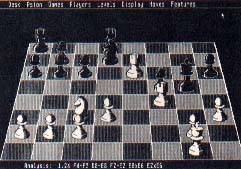 |
| FIGURE 2: Psion Chess |
PSION CHESS
Like Chessmaster 2000, a GEM-based program, Psion Chess projects a sophisticated European image with built-in support for six languages (English, French, German, Swedish, Italian and Spanish), online help files, and German-style pieces in the two-dimensional board display, the only one to occupy a movable window. Unfortunately, this port from the original Macintosh version underutilizes GEM (for example, many dialog boxes ask the generic "Are you sure? Yes/No" question rather than a task-specific "Begin a new game? OK/Cancel") and presents a simple but substandard user interface. I would have liked control key equivalents for menu choices and to be able to use desk accessories.
Judging from the impressive tournament results, though, Psion has chosen to emphasize playing strength at the expense of bells and whistles. The program offers more playing levels than Chessmaster, including a unique "Equal" mode that makes it spend just as much time as its opponent, and super fast two-and four-second speeds. The three-dimensional display is similar to Chessmaster's in appearance, but the better accuracy of the mouse control system is achieved at the expense of speed, since two long mouse clicks are necessary to pick up and deposit a piece.
In general, Psion's features are a well-chosen subset of Chessmaster's. All the essentials are available, but you won't find anything particularly innovative. The 24-page manual seems impressive until you notice that only four of those pages are in English.
Unfortunately, the real problem with Psion Chess is its unique "limboware" status: Psion Chess is a finished product, not vaporware or beta test rumor, but is simply unavailable as of this writing. Psion was released in late 1986 in final form and was available for a few months at several dealers, but by early 1987 it was off the market. Shortly thereafter, Atari announced plans to assume worldwide marketing of the ST version, but nothing has happened since. Atari's plans on distribution, as well as copy protection and other issues, are unknown. We can only hope that by the time you read this, Psion Chess is available again.
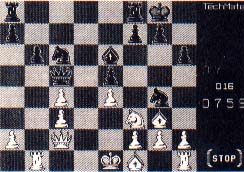 |
| FIGURE 3: TechMate |
TECHMATE
Compared with Chessmaster and Psion, Techmate is in a different class in both features and playing strength. In this age of feature-laden, easy-to-use, GEM-based chess software, Techmate seems out of place with its spartan display, single mode of play, and stubborn refusal to resign even when faced with mate in one move. It has no three-dimensional display, although its two-dimensional pieces are the best of the three programs. It offers only sudden death time countdown, although you can set the number of seconds for each player to complete the game. It has no facilities for saving games, keeping score, replaying games, or setting up arbitrary positions; for no apparent reasons, it does not "think" on its opponent's time and uses only a minuscule opening book.
But despite its numerous flaws, Techmate has entertained me by giving an exciting game of 100 second chess, an extreme form of blitz that would be difficult with Chessmaster or Psion given their awkward mouse controls. With Techmate, you just click as fast as you like on the piece and the square you want to move it to, and bang! the move is made. It can he disheartening at first to see Techmate respond just as fast (Chessmaster spends two or three seconds just sliding its pieces across the board, even in book openings). The support provided by Szabo Software for Techmate serves as a model for the entire software industry, and includes free newsletters and updates (I have received two of each) as well as a 50 percent discount on the next major revision, which is promised to have plenty of the bells and whistles missing here.
THE COMPETITION
There were five other players in the tournament: three human and two high-tech. All five--humans and machines--have ratings from the United States Chess Federation (USCF).
The USCF rates each player on a scale from 0 to 3000. A perfect player would be 3000, but a 3000-rated player could never really exist. The (human) world champion and his top rivals are rated around 2700, whereas the highest rated chess computer, HiTech, is rated around 2400. 2200 is Master level, 2000 is Expert level, 1800 is Class A, 1600 is Class B, and 1400 is Class C. The average serious novice is usually rated between 1100 and 1300 after his or her first tournament. Each tournament performance changes your rating according to the strength of the opposition and your score against it, although you always gain some points from a victory and lose some from a loss. (All three human players below are experienced tournament players.)
- Christopher Chabris is a computer science student at Harvard and is rated among the top 50 chess players in the U.S. under 21 years of age. He has a USCF rating of 2206--a Master.
- David Keck is a full-time programmer who works on IBM minicomputers. He has a USCF rating of 2127.
- Paul Keck is a freelance photographer. He has a USCF rating ol 1455.
- Sargon III is often called the dean of microcomputer chess programs. We used the Apple Macintosh Plus version for the tournament (an ST version should be available soon). Sargon III's IBM PC version has a USCF rating of 1850.
- The Novag Superconstellation is a $200 dedicated chess computer with its own pieces and auto-sensory board; its brain is a 6502 processor, the chip that serves as CPU for the Atari 8-bit computers and the Apple II. It has a USCF rating of 2018.
ROUND 1
The tournament ran two rounds and 42 games, conducted over a period of nine days. You'll find the 12 most interesting games from Round 1 and all the games from Round 2 of the tournament on Antic Online, the Atari online magazine on CompuServe. Just log on to CompuServe and type GO ANTIC, then check the "What's New" menu to find the CHESS file. You can download and study the games, which I refer to below. Also, consult Figures 1 through 3 in this article for piece positions, which I refer to in the game descriptions.
In the first round, five "test players" - three human beings and two computer programs--played two games each, one with white and one with black, against the three ST programs. In the second round, the three ST programs squared off in head-to-head competition, with each playing the two others four games each; by the end of the tournament, each program had played 18 games against rated opponents.
Figure 4 shows the crosstable for Round 1. On the left are the three ST programs being evaluated; on top, their five opponents. The notation is straightforward--for example, "W0 / B1" in the upper-left corner box indicates that when Chessmaster 2000 had the white pieces against Chris Chabris, the program lost, but with black it won. A score of 1/2 indicates a drawn game for both players.
In order to complete the 30 games reasonably quickly (after all, who likes to watch computers play chess against each other?), I established a time limit of 40 moves in 10 minutes.
While not truly "blitz" chess speed, this average rate of 15 seconds per move is too fast for official rated tournaments but slow enough, I believe, to demonstrate the approximate playing skills of the participants.
Unfortunately, not every computer participant had a 15-second playing level available. We chose the 10-second level for the Novag Superconstellation because its dedicated hardware was likely to compensate for its 8-bit processor. Techmate has no discrete levels, allowing only "sudden death" time controls of a certain number of seconds to complete the entire game. We allotted it 900 seconds, or 15 minutes, for each first-round game (holding its opponents to the standard 40 moves in 10 minutes limit). Given the tournament's average game length of 48 moves, Techmate averaged over 18 seconds per move. Szabo Software says Techmate uses an average of 2 percent of its remaining time per move, so its time usage was in the same range as that of its opponents. Additionally, since Techmate does not "think" while awaiting input moves, we followed the manufacturer's recommendation and whenever possible set its computer opponents to the corresponding "handicap" mode.
Chessmaster 2000 had mixed results in Round 1. Although it managed to score full points against the two highest-rated players, including a fine victory over me in which it nicely exploited my incautious play (see Game 1), it could do no better against Sargon III and was lucky to escape with a single draw against the Superconstellation. Its 55 percent score earned it a performance rating slightly but not significantly lower than its advertising claims.
Techmate was simply outplayed by all its opponents but tester Paul Keck, who was troubled by time pressure in all his games. Its small opening book allowed its opponents to consistently get an advantage going into the middlegame where its play was marked by serious blunders, including both lost pieces and positional gaffes. Techmates performance rating was largely a function of the quality of its opposition.
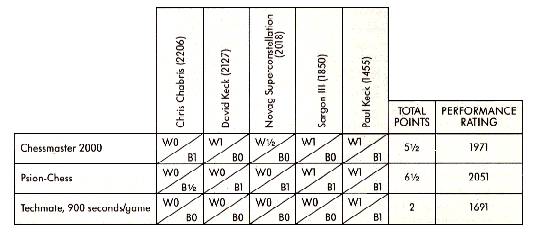 |
| Figure 4: Crosstable of Results for Round l of Experimental Tournament |
Psion Chess posted the best score by handling its computer opponents better than Chessmaster 2000; interestingly, it scored an astonishing 90 percent with the Black pieces but only 40 percent with the White compared to a more normal 36 percent-64 percent ratio for Chessmaster. Its two wins over Sargon II were impressive demonstrations of technique; in one instance it pounced on a positional error and patiently held the edge for twenty moves before converting it into a material advantage and simplifying into an endgame. But against me, despite playing creatively to obtain clear advantages in both games, it could only draw an endgame two pawns up in one and lose a winning position in the other (see Game 2).
ROUND 2
In round 2 the programs met in head-to-head competition. The time procedures used in Round 1 were applied here as well. Figure 5 shows the results of the three four-game mini-matches between the programs, their final ratings, and their total scores for the tournament.
After being disappointed with Techmates performance in Round 1, we tried various increased time settings ranging from 1200 to 2000 seconds to complete the game in Round 2. But despite consuming as much as 35 seconds (on average) over some move sequences, Techmate registered little improvement. Against Psion Chess, three of four losses were attributable to wild lunges with the pawns guarding the king, which also often failed to castle into safety. In one game it missed three winning attempts in the endgame. However, it played Chessmaster 2000 evenly for most of one game and actually defeated it in another with some well-executed defensive ideas (see Game 3).
The crucial match was the final battle between Chessmaster 2000 and Psion Chess, which had each already proven superior to Techmate. But although Chessmaster 2000's loss to Techmate suggested that it would lose to Psion Chess, we hardly expected an 87.5 percent blowout. Psion built up impressive positional pressure as Black in the first game but after Chessmaster's clever counterattack forced a trade of all the pieces but the rooks, we abandoned the game as a draw.
In the second game, Psion's unorthodox opening confused Chessmaster, which dropped a pawn and squandered opportunities for counterplay in a long endgame. But Chessmaster seemed ready to turn things around in the next game (see Game 4), when it "outbooked" Psion's French Defense in the opening and built up a powerful attacking position. After a sudden blunder lost it the exchange, it fought back in distinctly non-computer style with a kingside attack and transposed to an unclear endgame with chances for both sides. However, Psion prevailed as Chessmaster lost two key pawns and was pushed back on the defensive, resigning after a titanic 77-move struggle Now the clear winner, Psion demonstrated its clear superiority in the final, anticlimactic game with a pretty 5-move mating combination against Chessmaster's wayward king (see Game 5).
ANALYSIS AND RESULTS
The 42 games of the tournament illuminated several interesting aspects of the programs' play. Psion Chess demonstrated the most innovative opening repetoire, gaining early advantages in several games by taking its opponent "out of book," a tactic nominally used against computers, not by them. Its creative, human-like style, comparable to that of the Superconstellation, generated fewer awkward "computer moves" than its competitors. But perhaps most significantly, Psion managed its time and analysis well enough to simply look deeper than its opponents.
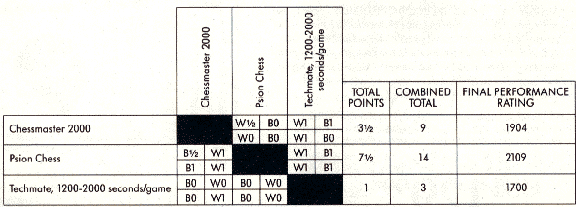 |
| Figure 5: Crosstable of Results for Round 2 of Experimental Tournament |
Chessmaster's strength was in orthodox play--except when trapped by Psion's opening tricks, it reached a good position in the middlegame; it also countered to some extent the common tendency of chess programs to aim for reduced tension by keeping the queens on the board. However, it overlooked mate-in-2 in one game, and a tendency for illogical maneuvers continually got it in trouble. With its tiny opening book, often extending no more than four obvious moves, Techmate rarely survived the opening without losing pieces. But when it did, as in its three victories, its play was reasonably solid, leading us to speculate that its basic algorithms are little worse than those of Psion and Chessmaster, but that its supporting facilities are inadequate.
FINAL RESULTS
The final ratings for the programs, which include all 18 tournament games for each, show 200-point gaps between them. Techmate comes in at Class-B level, Chessmaster 2000 at Class-A, and Psion Chess as an Expert player. It was a surprise to see Chessmaster and Psion finish in the order opposite the one we had initially predicted.
I can't stress enough that these results are meant only as guidelines. The tournament adhered carefully to time procedures and other relevant chess rules, but it provided too small a sample of games to guarantee statistical accuracy. USCF rules specify that 25 games are necessary to establish a rating and that those games may be played at speeds no faster than one move per minute. Neither condition was satisfied in our tourney, so you should view these results as experimental rather than definitive.
Which game is the best for you? If you are an expert-level or stronger player, Psion Chess is the best choice for an ST chess program, followed by Chessmaster 2000; Techmate is out unless you want a challenge at blitz time controls of two or three minutes for the entire game. If you are a serious tournament player but are still at a level below high Class-A, I recommend Chessmaster 2000 for its features and all-around high quality. Techmate would provide a blitz challenge, but is inadequate as a complete study tool. Beginners should also choose Chessmaster 2000, but should keep in mind the ratings mentioned in the tournament section of this article can be altered easily by allotting more or less time or using a handicap mode--don't get scared away!
On a personal note, I'd like to thank David and Paul Keck for providing their time, expertise, and computers for this tournament, without which it would not have succeeded.
Though they were the only participants in the first START chess tournament, Chessmaster 2000, Psion Chess and Techmate are by no means the last word in chess for the Atari ST. Later this year we can look forward to a new and improved Techmate II, along with the ST version of Sargon III from Spinnaker/Hayden. They'll be participating in the next ST chess tournament--coming soon to a magazine near you!
Chris Chabris, chess player extraordinaire, has just finished his first book--Artificial Intelligence and Turbo Pascal, published by Dow Jones--lrwin/Multiscience Press.
Psion Chess. Atari Corp., 1196 Borregas Avenue, P: O. Box 3427, Sunnyvale, CA 94088. (408) 745-2000; or Psion Limited, 2 Huntsworth Mews, Gloucester Place, London NWI 6DD, United Kingdom. Current program status and price are unknown.
Chessmaster 2000, Electronic Arts, 1820 Gateway Drive, Santeo, CA, 94404 (415) 572-XXXX. $44.95; or from The Software Toolworks, One Toolworks Plaza, 13557 Ventura Boulevard, Sherman Oaks, CA, 91423. (818) 907-6789.
Techmate. Michtron Inc., 576 S. Telegraph, Pontiac, Ml, 48053, (313) 334-5700. $49.95; or from Szabo Software P.O. Box 623, Borrego Springs, CA, 92004.
United States Chess Federation, 186 Route 9W New Windsor, NY, 12550. (914) 562-8350.